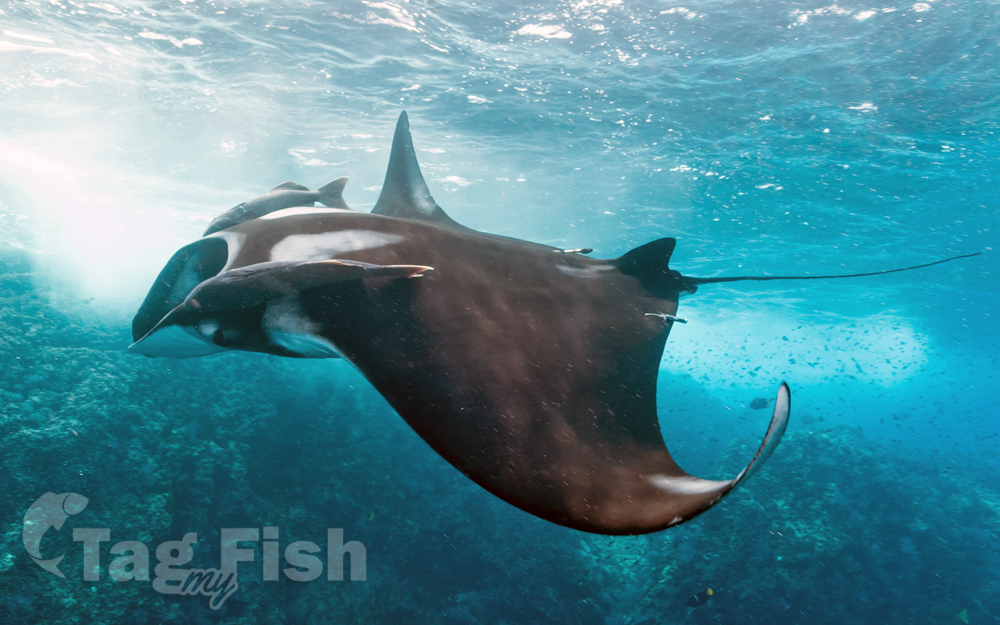Giant manta ray
(Mobula birostris)

Classification
General data
The giant oceanic manta ray, giant manta ray, or oceanic manta ray, (Mobula birostris) is a species of ray in the family Mobulidae, and the largest type of ray in the world. It is circumglobal and is typically found in tropical and subtropical waters, but can also be found in temperate waters. Until 2017, the species was classified in the genus Manta, along with the smaller reef manta ray (Mobula alfredi). DNA testing revealed that both species are more closely related to rays of the genus Mobula than previously thought. As a result, the giant manta was renamed as Mobula birostris to reflect the new classification.
Description
The giant oceanic manta ray can grow to a disc size of up to 7 m (23 ft) across with a weight of about 3,000 kg (6,600 lb) but the average size commonly observed is 4.5 m (15 ft).
It is dorsoventrally flattened and has large, triangular pectoral fins on either side of the disc. At the front, it has a pair of cephalic fins which are forward extensions of the pectoral fins. These can be rolled up in a spiral for swimming or can be flared out to channel water into the large, forward-pointing, rectangular mouth when the animal is feeding.
The teeth are in a band of 18 rows and are restricted to the central part of the lower jaw. The eyes and the spiracles are on the side of the head behind the cephalic fins, and the gill slits are on the ventral (under) surface. It has a small dorsal fin and the tail is long and whip-like. The manta ray does not have a spiny tail as do the closely related devil rays (Mobula spp.) but has a knob-like bulge at the base of its tail.
The skin is smooth with a scattering of conical and ridge-shaped tubercles. The coloring of the dorsal (upper) surface is black, dark brown, or steely blue, sometimes with a few pale spots and usually with a pale edge. The ventral surface is white, sometimes with dark spots and blotches. The markings can often be used to recognize individual fish. Mobula birostris is similar in appearance to Mobula alfredi and the two species may be confused because their distribution overlaps. However, there are distinguishing features.
Physical distinctions between oceanic manta ray and reef manta ray
The oceanic manta ray is larger than the reef manta ray, 4 to 5 metres in average against 3 to 3.5 metres. However, if the observed rays are young, their size can easily bring confusion. Only the colour pattern remains an effective way to distinguish them. The reef manta ray has a dark dorsal side with usually two lighter areas on top of the head, looking like a nuanced gradient of its dark dominating back coloration and whitish to greyish, the longitudinal separation between these two lighter areas forms a kind of Y. While for the oceanic manta ray, the dorsal surface is deep dark and the two white areas are well marked without gradient effect. The line of separation between these two white areas forms meanwhile a T.
The difference can also be made by their ventral coloration, the reef manta ray has a white belly with often spots between the branchial gill slits and other spots spread across the trailing edge of pectoral fins and abdominal region. The oceanic manta ray has also a white ventral coloration with spots clustered around the lower region of its abdomen. Its cephalic fins, inside of its mouth, and its gill slits are often black.
Distribution and habitat
The giant oceanic manta ray has a widespread distribution in tropical and temperate waters worldwide. In the Northern Hemisphere, it has been recorded as far north as southern California and New Jersey in the United States, Aomori Prefecture in Japan, the Sinai Peninsula in Egypt, and the Azores in the northern Atlantic. In the Southern Hemisphere, it occurs as far south as Peru, Uruguay, South Africa, and New Zealand.
It is an ocean-going species and spends most of its life far from land, traveling with the currents and migrating to areas where upwellings of nutrient-rich water increase the availability of zooplankton. The oceanic manta ray is often found in association with offshore oceanic islands.










